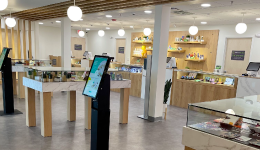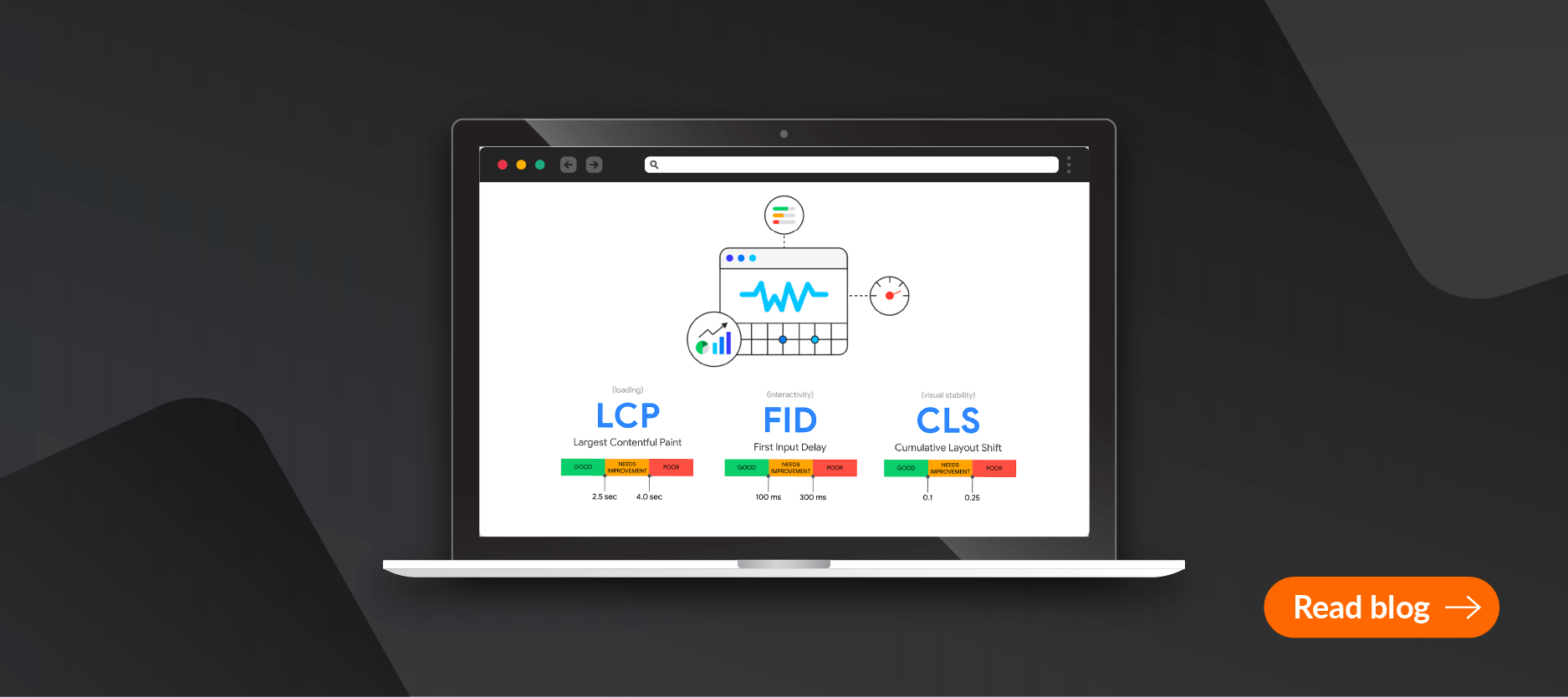Headless Commerce
The ultimate guide to make informed decisions before and during your headless journey.

- Introduction to Headless Commerce
- Advantages and Disadvantages of Headless Commerce
- Components of a Headless Commerce Infrastructure
- Challenges for Headless Hosting
- Headless Commerce Use Cases
- Advantages and Disadvantages of a PWA
- Preferred Front End and Back End Applications
- Webscale for Headless and PWA
Introduction to Headless Commerce
What is headless commerce?
Headless commerce is a very hot topic of discussion among merchants and developers today especially due to the growing number of shoppers using mobile devices to transact. According to Webscale’s Global Headless Report, 52% of developers and 46% of merchants surveyed agreed that headless is the number one tech trend in the world of ecommerce.
Headless commerce is a separation of the front end presentation layer and back end commerce functionality of an ecommerce web application. This decoupled architecture offers merchants the freedom to build new functionalities and engaging content and/or customer experiences, however they envision it.
In a traditional “monolithic” commerce model, new functionalities and experiences may require updates to both the front end and back end systems, where even minor updates can become long drawn projects with many challenges.
Often, an ecommerce business is very happy with their front end presentation layer and needs more from their back end infrastructure. The real value of headless commerce is that it allows merchants to retain what works best for them and add or upgrade what doesn’t.
What are the different ecommerce architectures?
Monolithic: In this model, the front end and back end components of the web application are joined to create one entity. A majority of ecommerce applications today are monolithic.
Commerce-led: In this, there is a commerce platform front end for user experience and checkout, and APIs for data orchestration across the infrastructure. In a commerce-led model, merchants typically use SaaS or open-source technologies and often implement a PIM, CRM, ERP, and OMS for managing the various functions.
Experience-led: Here, the ecommerce platform is separated from the front end presentation layer, so merchants can use their preferred CMS like WordPress, DXP like Crownpeak, PWA, or custom front end solutions for offering bespoke customer experiences. The ecommerce platform provides PCI DSS compliance and can be integrated with additional systems like PIM, CRM, ERP, and OMS via APIs.
The front end or the ‘head’ is the theme that controls what shoppers see when they visit an ecommerce website. Headless allows greater flexibility in content delivery or customer experience as merchants can connect a CMS, DXP, or Internet of Things (IoT) device that is custom designed for delivering content- or experience-led commerce. Here, both the front and back ends co-exist but any one can be altered without impacting the other.
What is an API?
API or Application Programming Interface, enables applications to exchange data and functionality easily and securely. Leveraging APIs, companies can open up their applications’ data and functionality to their internal departments or external third-party developers and business partners. Each API is a set of predefined rules that explain how services and products shall communicate with each other and leverage each other’s data and functionality. An API sits between an application and the web server, acting as an intermediary and processing data transfer between the systems. Without APIs, many of the most popular web applications of today would not be possible.
APIs offer multiple layers of security: by design, because the API endpoint decouples the requestor application from the service provider application. An API call includes authorization credentials and an API gateway can restrict access, both of which minimize security threats. Also, during the exchange, additional security layers to the data are offered by HTTP headers, cookies, or query string parameters.
What is a headless architecture?
In a headless architecture, the business logic and functionalities are encapsulated in a set of APIs that reside in the back end and the front end can connect to these APIs to offer the desired customer experiences.
This decoupled architecture offers greater flexibility and speed to create the front ends that an ecommerce business needs and the freedom to use best of breed solutions for each business function like an ecommerce platform, CMS, CRM, PIM, ERP, Payment and OMS.
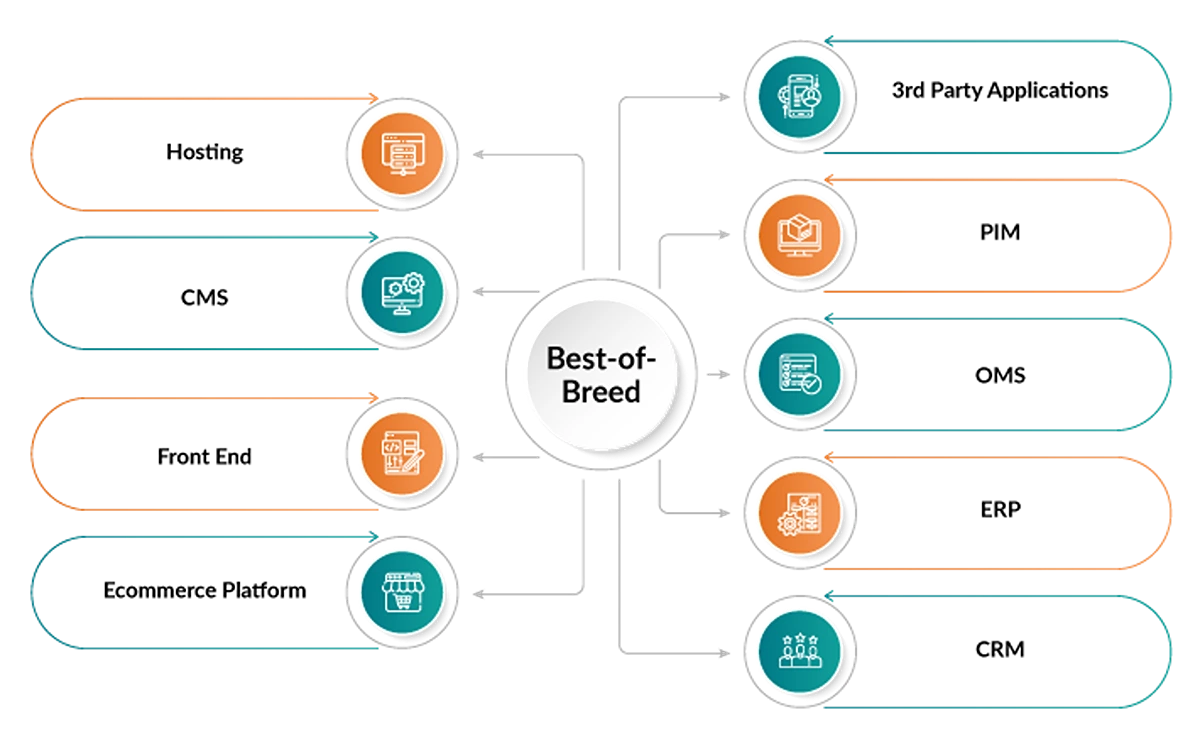
What do MACH and Jamstack denote in headless commerce?
MACH stands for Microservices, API-first, Cloud-native, and Headless. Javascript, APIs and Markup make up JAM in a Jamstack. MACH is a modern architectural approach to deliver the backend, while Jamstack is adopted for building the front end.
Both MACH and Jamstack practices enable the decoupling of static and dynamic content, allow the reuse of APIs instead of developing and maintaining app-specific databases, and host files on the cloud through a CDN.
If done right, both MACH and Jamstack approaches can offer never before flexibility, scalability, speed, openness and modularity.
In June 2022, Webscale joined the MACH Alliance as an Enabler to advocate for MACH as an ecommerce industry standard, and to deliver the best digital experiences for merchants and their customers
Headless commerce vs Traditional ecommerce?
As ecommerce merchants chase omnichannel ambitions, technology models offering utmost flexibility are chosen over rigid traditional structures.
In a headless approach, the customer side of the ecommerce application is decoupled from the technical side, offering never before flexibility that merchants and developers are increasingly looking for to create unique brand experience on the front end.
Traditional ecommerce: The most traditional ecommerce model is the monolithic. Many brands continue to follow a monolithic approach, and many developers even recommend it. The greatest disadvantages of a monolithic approach are slow time-to-market and high development cost. The biggest advantage of a monolithic application is complete control over the platform to offer a bespoke customer experience.
Headless commerce: Modern commerce increasingly relies on a headless approach where APIs come together to deliver unique brand experiences for customers across platforms, devices, browsers and regions.
What is a Headless CMS?
A headless CMS is any back end content management system where the content “body” is decoupled from the presentation layer, the “head.” Content residing in a headless CMS is delivered via APIs for display across devices. A headless CMS enables merchants to choose the most appropriate “ heads,” the presentation layers, and structures the same “body” of content reusing it across platforms and devices.
Here’s a detailed comparison of some of the leading headless CMS solutions.
Advantages and Disadvantages of Headless Commerce
What are the business benefits of headless commerce?
Speed to market: With headless commerce, ecommerce businesses can launch new front end experiences rapidly with minimum back end development effort for global and omnichannel go-to-markets.
Enhance Core Web Vitals (CWV) scores: With Google emphasizing CWV as a critical search signal, ecommerce websites have to ensure superior performance and user experience in order to maintain their search ranking. Headless solutions can play a major role in reducing delivery time and improving CWV scores, using tactics like static page generation, cache delivery and more. In turn, faster page speeds and a flawless user experience mean customers get to see more of the catalog and are likely to buy more.
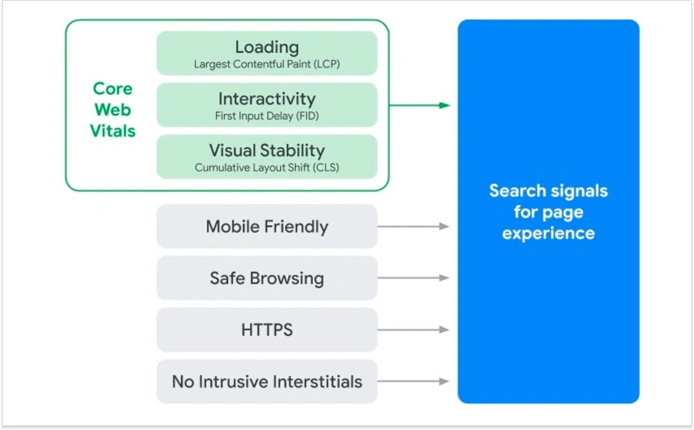
Customize and personalize the experience: With the front end and back end decoupled, marketing and design teams can focus on sales promotions, conversions and overall user experience, while engineering teams can move at their own speed to maintain stability, security and consistency on the back end.
Better employee productivity and satisfaction: Headless commerce provides developers with absolute flexibility and control, and easy to use templates to create compelling user experiences leveraging APIs and third-party commerce services like CRM, ERP, PIM, OMS, and others. The simplicity of the approach ensures everyone can contribute even without advanced technical skills.
Zero friction between teams: Developers and designers do not make a tribe! Developers use APIs, coding and tools offered by ecommerce platforms to build compelling yet consistent user experiences across omnichannels leveraging the same set of data. Designers focus on optimizing the customer experiences across omnichannels to maximize user engagement and conversions. With a headless approach, each team works at its own pace and without stepping on each other’s toes, achieving deeper collaboration and synergy.
Improved functionality and flexibility: Headless technologies are API-first, enhancing functionality and flexibility as changes can be made on the fly without impacting the back end, or origin, since they are decoupled, improving integration possibilities and eliminating downtime.
Foster innovation: A headless environment allows developers to test new technology without the fear of breaking anything as the front end is decoupled from the back end.
Accelerate conversions and lower customer acquisition costs: The customer acquisition cost in ecommerce is relatively high as businesses invest heavily in digital advertising to drive traffic to their sites. Yet only a percentage of that traffic will convert to customers and revenue. Headless offers the promise of optimizing customer acquisition cost as the content or experience-led strategy it champions helps drive organic traffic and the unique customer experiences it brings alive enhances conversions.
Scale as you grow: With a decoupled front end and back end, embracing new technology advancements is simplified. Headless infrastructure paired with PWAs, make great sense for businesses wanting to accelerate their path to mobile, while controlling their total cost of operations (development plus maintenance costs) and ensuring enhanced search visibility and performance.
Can going headless enhance your site’s Core Web Vitals?
The short answer is yes.
For far too long, the monolithic approach delivered by traditional ecommerce platforms has prevented merchants from offering the ultimate user experience, especially when it comes to site performance. It is a cruel joke that in an increasingly mobile first world, popular ecommerce platforms and their monolithic approach, have remained firmly mobile second.
Google’s Core Web Vitals is challenging the ecommerce industry to up their game, to get mobile-ready and put customer experience at the top of the priority list. Failure to do so will impact search rankings, sending visibility, traffic, and revenue into a downward spiral. A static generated front end, coupled with any commodity back end that is able to serve capacity requirements, is a reliable path to achieving good Core Web Vitals scores, if executed well by experienced partners.
How does headless commerce impact ecommerce customers?
Personalized and engaging omnichannel user experience: The decoupled structure of headless commerce allows merchants to distribute content more effectively across devices and browsers, whether online or offline, ensuring a seamless brand experience for customers, regardless of the touchpoint.
Blazing fast websites: In a headless deployment, any new experience or functionality introduced are reflected instantaneously across all the front ends as they rely on API calls. Traditional ecommerce websites can take minutes or longer for all users to see the new updates.
What are the disadvantages of headless commerce?
Slower time-to-market: An average headless build can take 4-6 months, so merchants need to make a significant time commitment. As more agencies develop accelerator programs and more out-of-the-box solutions become available, we expect to see this timeframe reduced.
High cost of development and maintenance: There is a high price tag associated with headless today. It requires a complete overhaul of the front end experience, and third party integrations are still an evolving landscape, potentially causing some maintenance headaches down the road. As always, working with great partners is critical and Webscale is happy to recommend one that best fits your needs from its global ecosystem of digital agencies.
Is headless commerce the right path for your business?
Certainly, headless is not the right path for any and every ecommerce business. The biggest reason being it involves significant effort and cost, and requires a long term commitment to realize a return on investment. To start with, decide to go the headless route, if the business goals demand it and not because one is compelled to follow the herd. If the business has to offer advanced personalization and highly customized omnichannel experiences, then headless is the best bet.
Components of a Headless Commerce Infrastructure
What are the components of a robust headless infrastructure?
Tech Stack: Avoid the disruptive and wasteful expenditure caused by discarding your existing ecommerce platform, ERP, CRM, PIM, and OMS for “rip and replace” headless commerce solutions. Choosing a leading headless CMS however is a good investment, as it will enable easier management of the front end.
Cloud delivery: An important aspect to consider is delivery of your headless storefront in the cloud. Choose a cloud provider that has ecommerce and specifically headless expertise, has invested in automation and machine learning to offer you deep visibility and insight into your traffic and infrastructure, and above all, understands the time criticality of support.
In-house or outsource: Cloud and DevOps talent is in short supply and many ecommerce companies struggle to find the right personnel. Engaging a specialist digital agency in this situation will help ensure the success of your headless project. Webscale works with a global ecosystem of digital agency partners experienced in developing headless and PWA storefronts, and makes recommendations frequently to merchants embarking on these projects.
A decision for today and tomorrow: While making decisions on what components of your tech stack should be used or replaced, be realistic about the total cost of operations (acquisition/development plus maintenance) and be conscious of technical debt. Making good decisions today will deliver the best return on investment in the years to come.
What are Microservices?
The best way to build the headless back end is through a microservices approach. Microservices (or microservices architecture) are a cloud native architectural approach to software development in which a single application is composed of many loosely coupled and independently deployable smaller components, or services, that communicate with each other over well-defined APIs.
A microservices architecture makes it easier to design, build and deploy applications and to scale them rapidly, driving innovation and expediting time-to-market for new features and functionalities.
Characteristics of Microservices
Independent: Each microservice in a microservices architecture is an independent entity that does not require to share their code or implementation with the other microservices. Each microservice (catalog, search, cart, checkout, payment, CMS) can be developed, deployed, operated, and scaled without impacting the functioning of other microservices.
Specialized: Each microservice is designed to deliver a set of capabilities to effectively solve a specific business problem.
What are Packaged Business Capabilities (PBCs)?
PBCs are used as building blocks for application product suites and custom-assembled application experiences in a headless build.
According to Gartner, a packaged business capability, is a “software component that represents a well-defined business capability, recognizable as such by a business user…[and] consists of a bounded collection comprising a data schema and a set of services, APIs and event channels.”
A PBC is an application or service built around a specific business function. Rather than the function being one component of a larger, monolithic application (such as an ecommerce platform, CRM or CMS), a PBC is decoupled from other services and communicates with other components through APIs.
Sounds like microservices? A PBC involves a grouping of APIs that serve a specific business capability, whereas microservices are more tightly scoped and granular (though microservices may also have multiple APIs and endpoints within them). If a microservice represents a business capability in a way that is clear to a business user, it qualifies as a PBC.
PBCs can be considered aggregations of microservices. The number of microservices can be one or more.
Rip and Replace approach vs Best-of-Breed approach?
There are many headless point solutions becoming available, yet many advocate a rip and replace strategy for merchants wanting to go headless. Many merchants and developers agree that this is not the best approach from the merchant’s point of view, given the disruption, uncertainty and cost.
A headless strategy should adopt a “best-of-breed” approach in place of an “all-in-one” solution. This is what defines true flexibility.
Many merchants have already made significant investments in an ecommerce platform, ERP, and other systems, and writing off these investments is one of the key concerns of merchants wanting to go headless. An ideal headless approach will need to provide the type of flexibility that allows merchants to leverage existing technologies and incrementally move forward in their headless journey, taking advantage of the very best tools available for specific aspects of their business.
Challenges for Headless Hosting
What are the major hosting challenges for a headless store?
Multiple platforms: Since a headless approach will involve different platforms for the front end and back end, the hosting provider will need to support both. A hosting provider with a platform agnostic approach is best.
Availability: Like any ecommerce site, a headless storefront will also see huge spikes in traffic during the holiday season and sales promotions. All components of the headless storefront should be able to deliver under peak load. A hosting provider with auto-scaling capability is highly recommended to avoid unplanned downtime or sluggish page performance when traffic hits.
Performance: In ecommerce, time is money. If the site is not fast, bounce rate will increase and conversions will drop. And with Core Web Vitals becoming a search signal for Google, poor site performance will impact search visibility and thereby organic traffic. Engage a hosting provider that relies on end-end performance optimization and deep observability that helps to address issues quickly to deliver lightning fast pages. A static generated front end, coupled with any commodity back end that is able to serve capacity requirements, is a reliable path to achieving good Core Web Vitals scores, if well executed by an experienced digital agency.
Security: In a headless storefront, since more than one platform needs to be hosted, it’s likely that they are using their respective hosting accounts, maybe even a different cloud service provider. The merchant may manage those hosting accounts directly or engage a managed hosting provider. Whatever the approach, use a security technology that offers end-to-end protection from the origin to the edge.
Analytics and Control: Every headless ecommerce storefront needs a deep analytics and control tool for proactively monitoring and managing the health of the hosted applications. While there are many tools available in the market, they are either limited in scope or difficult to integrate. Engage a hosting provider that offers deep observability into every aspect of your online business: user experience, CDN, security, application performance, and code deployments and their overall impact on conversions and revenue. With monitoring and detection automated (less or no people power), management and remedial action can be proactive instead of reactive.
Support: When a sale is going on, the last thing merchants want is to wait for a ticket to be responded to by the hosting provider. Rapid, SLA-bound 24x7x365 DevSecOps support and SRE (site reliability engineering) by certified ecommerce and cloud experts should be provided by the hosting provider.
Digital agency/Developer: Headless commerce by its very nature offers creative freedom and flexibility to develop applications to suit a merchant’s unique business case. Engage a hosting provider that works in close collaboration with digital agencies and the developer community, and better still, can recommend a best fit digital agency from their ecosystem of partners that best suits your needs.
What are Front-end as a Service (FEaaS) solutions for headless?
For an ecommerce store, the content and customer experiences can come from different sources – CMS, ERP, PIM, OMS, CRM, and others – and get delivered to any target device – mobile, desktop, point of sale display, wearables, smart mirrors and other IoT devices.
In a Frontend-as-a-Service (FEaaS) platform, these pieces are fused into building blocks which are combined to deliver device specific layouts. The biggest advantage being since developers are not required to create the layouts, they can focus on integrations, new functionalities and expansion of the modular system.
Headless Commerce Use Cases
Headless commerce use cases for you to consider
Custom-build: If you are certain the customer experience cannot be delivered out of the box by any one system, then there is a business case to custom build it. In a headless approach, the APIs enable the flexibility required to transcend the limitations of any one platform or technology.
Headless + CMS build: Here, the headless approach is combined with a CMS. As the ecommerce platform is decoupled from the front end, a merchant can deploy any popular CMS solution like WordPress, DXPs like Crownpeak, or custom front end solutions for superior customer experiences that enhance engagement and conversion.
In this model, the ecommerce platform can be connected to the CRM, ERP, PIM, or OMS via APIs, and takes care of PCI compliance and inventory management.
PWA: Progressive web apps (PWA) are web applications that deliver a native app-like experience to users. PWAs are regular web pages or websites but appear to the user like traditional applications or native mobile applications. PWAs bring together the best of websites and mobile applications to create an immersive user experience that can lead to more time being spent on the site and higher conversion rates.
For a full technical download on everything PWA, here’s a session anchored by Webscale and our digital agency partner, Corra.
Advantages and Disadvantages of a PWA
What are the advantages of a PWA?
Offline availability: PWAs, like mobile apps, and unlike websites, allow users to access them while not online. This means greater availability which drives deeper engagement.
Mobile-like experiences: PWAs bring together the best of websites and mobile applications. Like websites they are indexable by search engines which enhances their visibility and organic traffic, while offering core website functionalities like dynamic data and database access. Like mobile applications, PWAs offer faster page loads and far better UX compared to websites.
Robust security: PWAs use HTTPS to secure their data thereby mitigating risks associated with malicious activities.
Single-click installation: A PWA can be downloaded onto any device from a website and gets its own icon on phones and tablets. A PWA can also be listed in the Google Play Store (not yet allowed on the Apple App Store).
Skip the app stores: It is absolutely discretionary to publish a PWA on any app store. Which means merchants can not only entirely skip the tedious submission process but also push new updates on the fly without having to wait for app store approvals. New updates are auto-downloaded on a PWA when users relaunch it.
Push notifications: Like native mobile applications, PWAs allow push notifications to user devices making it a powerful marketing and sales enabler.
Hardware features: PWAs can use typical hardware features of mobile devices such as geolocation and camera.
Developer time and cost optimization: Websites have to be responsive and mobile applications have to be individually developed for different devices. But a PWA is platform, screen and device agnostic
significantly reducing developer time and thereby associated cost.
What are the disadvantages of a PWA?
Lack of presence on Apple App Store: The biggest disadvantage often cited about a PWA is its inability to make it to one of the world’s largest app aggregators – Apple App Store, severely impacting their visibility. iPhone and iPad users have to visit the brand’s website to download the PWA.
Limitations on using hardware features: While geolocation and camera features of user devices can be used by a PWA, many other critical hardware features like accessing contacts and calendar, or Bluetooth and NFC are not yet possible, impacting the user experience.
Drain on device battery: Since a PWA requires intense CPU usage, it leads to fast battery drainage which can be a hassle especially for mobile users.
If you need help to decide whether you require a PWA for your business, here’s an insightful blog authored by Atwix, one of our digital agency partners.
Preferred Front End and Back End Applications for Building a Headless Storefront
Which are the most preferred front end applications for building a headless storefront?
Vue is a JavaScript framework for building user interfaces (UI) and UI components on the web. Unlike monolithic frameworks, Vue is designed to be incrementally adoptable. The open-source core library is focused on the view layer only, and can be seamlessly integrated with other libraries or existing projects. Vue can also power Single-Page Applications (SPA) when used along with other libraries and tools.
In May 2022, Webscale and Vue Storefront announced a strategic partnership to deliver fast and secure PWAs for merchants across multiple ecommerce platforms and shopping carts.
React is a JavaScript library developed for building fast and interactive user interfaces for web and mobile applications. Maintained by Meta (formerly Facebook) it is an open-source, component-based, front-end library responsible only for the application’s view layer. It can be used along with other JavaScript libraries and frameworks.
Angular is a TypeScript-based open-source component-based framework for building scalable web applications. It is a collection of well-integrated libraries that cover a wide variety of features, including routing, forms management, client-server communication, and more. It also includes a suite of developer tools to help develop, build, test, and update code.
Gatsby provides ecommerce development teams an open source front end framework (React) for creating dynamic, optimized websites and a cloud platform for delivering them on a blazing fast edge network that scales to manage increased traffic. It leverages the JAMstack to make sites lightning-fast.
Here’s a detailed comparison of some of the leading front end applications.
Which are the most preferred backend applications for building a headless storefront?
Adobe Commerce takes Magento Commerce (the enterprise version of Magento) a step further by making it fully managed and cloud-based, and possible to integrate with Adobe Experience Manager seamlessly.
BigCommerce is a cloud-based ecommerce platform that offers a set of online store management features (online payment methods, analytics, order fulfillment, etc.) as well as content management features, and hosting and security services for an online store.
SAP Commerce Cloud is a proven commerce solution built mainly for large enterprises with advanced B2B, B2C, and B2B2C use cases. The solution can be customized to meet specific needs and manage even the most complex catalogs, products, and configurations for creating exceptional, hyper-personalized omnichannel experiences.
Salesforce Commerce Cloud, formerly called Demandware, is a cloud-based service for unifying the way businesses engage with customers over any channel or device. While Demandware technology underlies Commerce Cloud, it is also strongly linked to other Salesforce products, including the Sales, Marketing and Service Clouds, and Salesforce Einstein, the artificial intelligence platform.

Shopify Plus is a fully hosted enterprise ecommerce platform designed for high growth merchants and brands. Shopify has added a robust set of features to their Plus offering – higher degree of customization with access to their theme language Liquid; greater customization and control over checkout; more API integrations; exclusive access to advanced Shopify apps like wholesale channel for B2B sales; and deeper visibility and analytics.
Shopware 6 is an enterprise-grade ecommerce platform and the market leader in Germany. They also have Shopware PWA created in partnership with Vue Storefront as a dedicated headless frontend for Shopware 6 that focuses on an API-first approach.
Oracle Commerce is a unified B2B and B2C ecommerce platform that makes digital sales channels central to a merchant’s success by building personalized, online buyer experiences, innovating faster, and boosting sales. It easily integrates with Oracle and non-Oracle ERP, CPQ, content, and supply chain applications to support a variety of selling and business models.
HCL Commerce (formerly IBM WebSphere Commerce) is an enterprise ecommerce platform delivering powerful B2C and B2B experiences all on the same platform.
WooCommerce is an open-source, customizable plugin that adds an ecommerce functionality to a WordPress site so a merchant can have an online store. Here’s a detailed comparison of some of the leading back end applications.
Webscale for Headless and PWA
What is a headless PWA?
When a merchant chooses the PWA route to go headless, it’s called a headless PWA. As a matter of fact, merchants do not have to compulsorily pursue headless commerce with a PWA because it is just one of the approaches available. A traditional, dynamic website or native app can also be used to decouple the back end of your ecommerce platform. A headless PWA makes great sense for businesses wanting to accelerate their path to mobile, while controlling their total cost of operations (development plus maintenance costs).
ScandiPWA, Vue Storefront and PWA Studio (Adobe) are three popular headless PWA solutions available in the market.
Webscale for Headless Commerce Infrastructure and PWA Delivery
Webscale has the technology and expertise to ensure merchants don’t have to lose their head while going headless.
Webscale is learning daily from managing hundreds of merchants, thousands of storefronts, millions of users worldwide and billions of dollars in revenue every year.
We have been delivering, managing and securing headless storefronts on the public cloud for years. Our Intelligent CloudOps platform, Webscale One, enables merchants to
quickly launch PWAs that combine traditional website functionalities with the best mobile app features.
Webscale offers tailor-made infrastructure, software and services with complete observability into how the performance, security and availability are impacting the user experience across multiple devices. Combined with the Webscale VelocityEDGE, and advanced Webscale features like automatic image optimization, Site Splice and Dynamic Site Cache, the benefits to merchants include incredible performance and scalability at every layer of the application.
Leveraging Webscale’s end-to-end PWA delivery, that integrates with any market-proven open source or licensed PWA framework, or Jamstack, Webscale accelerates a merchant’s ability to deliver new microservices quickly, securely, and without downtime.
Download the Solution Brief.
Headless Commerce starter checklist
Here’s a simple checklist which we have created based on our experience to help you kickstart your headless project and see it through to go live.
Step 1: Choose an {ecommerce platform} for product management and shopping cart
Step 2: Identify a {headless CMS} for content management
Step 3: Select a {front end application} for customizing UX
Step 4: Engage a {digital agency} partnered with Webscale for front end or full stack development
Step 5: Trust Webscale for infrastructure, software and services with laser focus on performance, security, availability, and ongoing success
Few successful headless deployments powered by Webscale
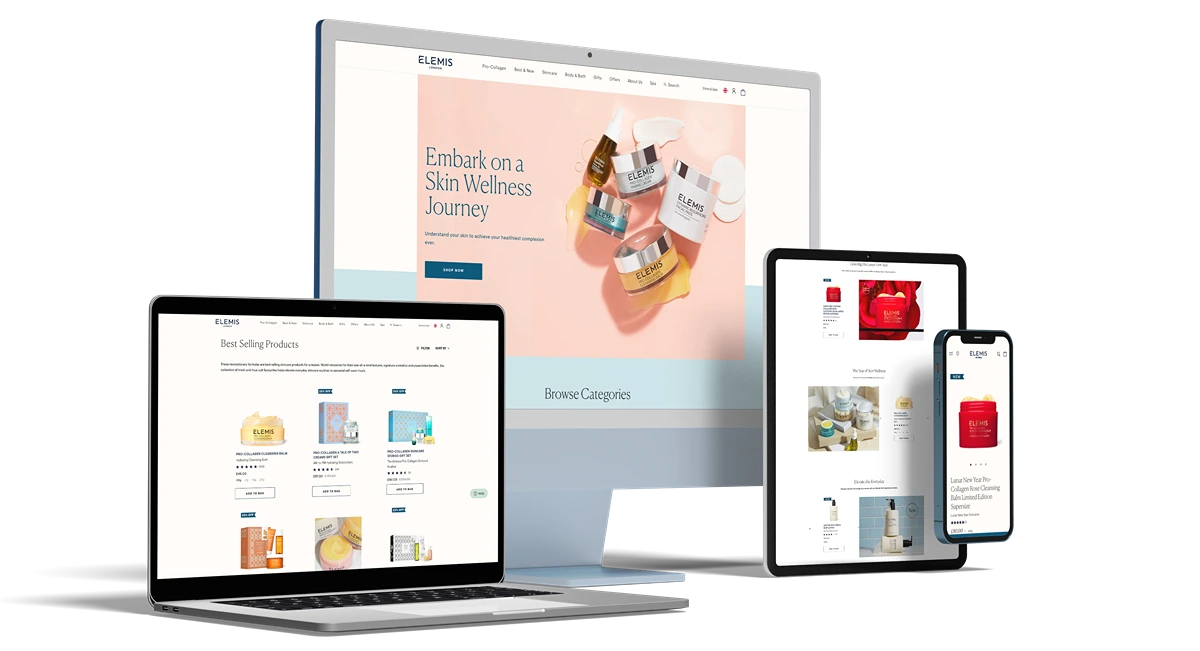
Elemis is a leading luxury British skincare brand with award-winning products for face and body. In 2019, it was acquired by French beauty brand L’Occitane.
Ecommerce platform: Adobe Commerce
Monthly unique visitors (Traffic): 771K
Pain points to solve: Britain’s number one independent skincare brand was building a lightning-fast PWA. They needed extra security beyond what they could receive from Fastly/PerimeterX
Webscale offerings: PWA Delivery, CloudEDGE Security and Platinum Support Package
Outcome: Two mobile-first, 360-degree secure and equally fast PWAs to cater to both EU and US markets reported a 150% lift in transactions, with mobile conversion rates increasing an astounding 483%
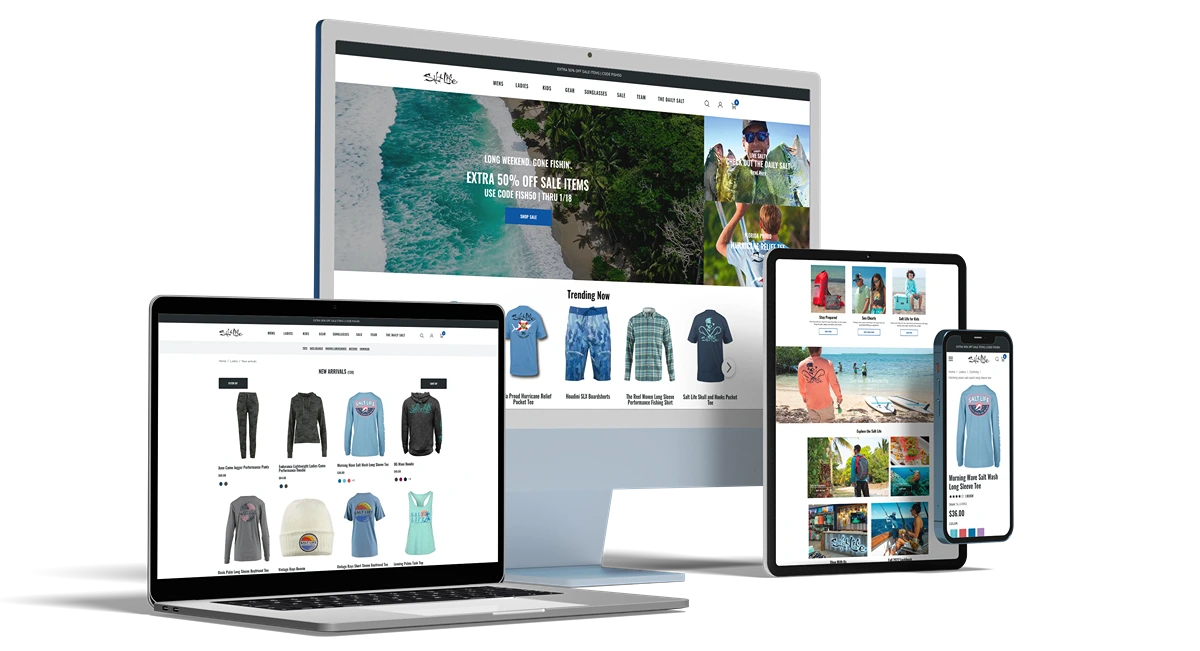
Salt Life is a lifestyle brand offering high quality apparel, performance gear and accessories for pursuing saltwater sports.
Ecommerce platform: Adobe Commerce
Monthly unique visitors (Traffic): 175K
Pain points to solve: The foremost ocean lifestyle brand wanted their new PWA build to be super-fast
Webscale offerings: Webscale Velocity and fully managed PWA Delivery on AWS
Outcome: After the switch to a PWA, Salt Life saw a 40% increase in organic traffic, 50% decrease in bounce rate, and a 15% percent increase in mobile conversion rate
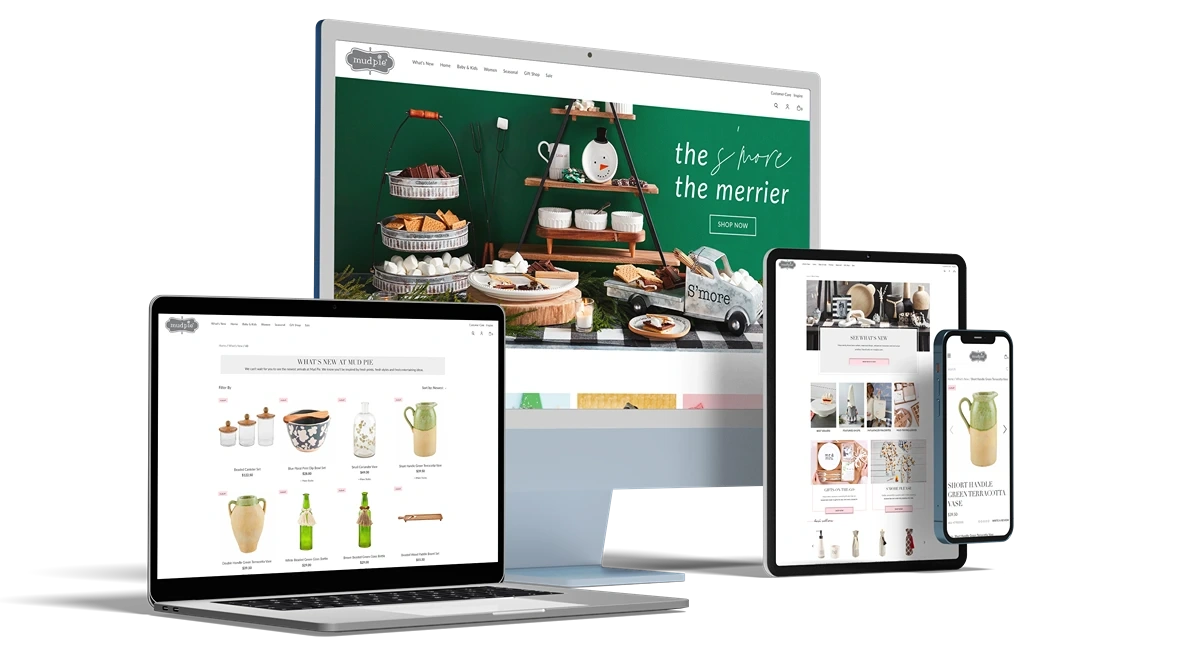
Mud Pie is a home décor and lifestyle brand founded in 1988 in Atlanta GA. They design, manufacture and distribute thousands of new products across three divisions: Home, Kids and Women.
Ecommerce platform: Adobe Commerce
Monthly unique visitors (Traffic): 145K
Pain points to solve: The leading home décor and lifestyle brand was experiencing high traffic and was looking for much better site speed and timely support; also tired of self-managing their Azure environment
Webscale offerings: Webscale Velocity and fully managed PWA Delivery on AWS
Outcome: A brand-new PWA site netting 90% increase in users starting a checkout process while losing no search traffic during the website’s re-platform

Since 2009, Moose Knuckles has been protecting Canadians from the cold with luxury winter clothing and outerwear engineered for the tundra yet designed for the city.
Ecommerce platform: Adobe Commerce
Monthly unique visitors (Traffic): 293K
Pain points to solve: The iconic clothing brand protecting Canadians from the cold for over 100 years now, wanted deep observability into their production environment in Adobe Experience Cloud. They were also concerned about security
Webscale offerings: CloudEDGE Security, Webscale Velocity, and fully managed PWA Delivery on AWS
Outcome: Super-fast and secure PWA store with significantly reduced time to resolution by Webscale for support requests

New York-based designer Roxanne Assoulin creates everyday jewelry like bracelets, necklaces, earrings, rings and anklets, that celebrates the mood-lifting power of color.
Ecommerce platform: Shopify Plus
Monthly unique visitors (Traffic): 18.3K
Pain points to solve: With physical stores shut during the pandemic, the eponymous jewelry brand was urgently building an innovative web application to engage with customers in a fun way. They were particular about security and seamless routing of requests
Webscale offerings: Fully managed PWA Delivery on AWS
Outcome: Since launch, RA YOUR WAY, the custom bracelet configurator app makes up 13.5% of product revenue and 9.95% of unique purchases. Additionally, AOV increased 10.5%



